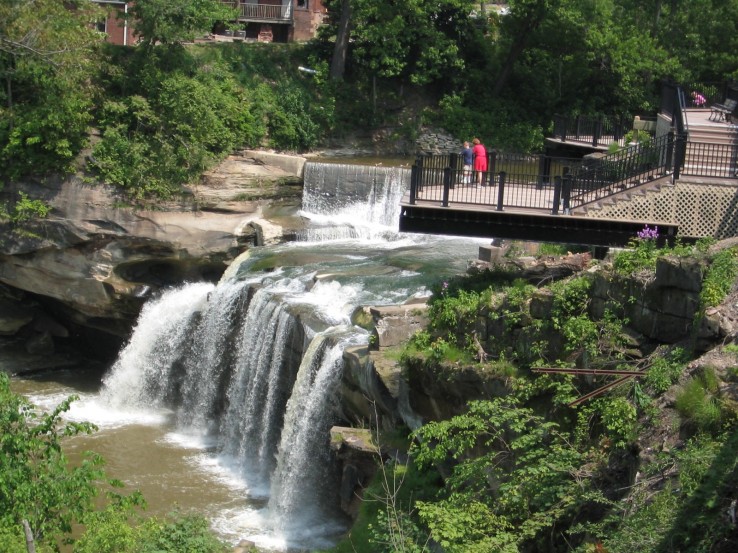On February 25, the NEOSCC Board voted unanimously to approve and endorse the Vibrant NEO 2040 Vision, Framework and Action Products. We are sharing an “Initiative A Day” so you can gain a better understanding of the vision and framework! If you would like to read all of the Initiatives, you can download them here: Recommendation and Initiatives. You can access a pdf of the entire vision chapter here. The vision chapter contains all 41 initiatives, development strategies, indicators, and matrices that identify how the recommendations, initiatives and indicators all relate.
Show your support for Vibrant NEO 2040 by adding your name to our Champions of Vibrant NEO 2040 list here.
Initiative 7.5: Expand collaboration between existing natural resource districts and consider the creation of new districts where appropriate.
WHAT THIS MEANS. Ohio, like many states, mandates a county-based network of soil and water conservation districts to comply with federal requirements. These districts are charged with advising local governments and landowners on best conservation practices as well as implementing various control infrastructures. While soil and water conservation districts are constituted to serve both urban and rural areas, the expertise and operational range of such districts are generally oriented more toward agriculture. Furthermore, as the geography of soil and water districts follows political (county) boundaries, management values applied for the benefit of one group of stakeholders may carry negative consequences for downstream stakeholders, or result in contradictory system outcomes. Some of the pitfalls associated with fragmented ecosystem management are discussed in 7.4.
The wording of this initiative suggests two alternative paths. One is to orchestrate collaborations between existing soil and water conservation districts on ecosystem-scale issues, either through a watershed partnership, regional councils of government, or a new collaborative structure. Another is to formalize the watershed scale of ecosystem management into a new kind of natural resource management district, potentially replacing existing soil and water conservation districts. Nebraska’s Natural Resource District (NRD) system provides a good model in this respect. NRDs are legal subdivisions of the State of the Nebraska that replace the county-based soil and water districts prevalent in many states and are charged with managing watersheds (including flood control), conserving soil resources, promoting best land management practices for farmers and ranchers, protecting critical habitat, and developing and maintaining local recreational areas and trail systems. They are organized around the state’s major drainage basins, so the scope of their programming and services effectively span human and ecological systems, and urban and rural contexts. A statewide association of NRDs helps to bind the system into a single community of practice, where best practices and knowledge are freely exchanged and serve to improve the programming and effectiveness of all NRDs.
WHY THIS IS IMPORTANT. Natural resources are products of highly dynamic systems playing out in multiple media (water, air, soil). It follows that natural resource management must be appropriately scaled and scoped to address issues playing out everywhere from the individual site to the watershed or air shed. The existing framework for natural resource protection and management stems largely unchanged from the New Deal era, itself a response to disastrous environmental management practices. With 21st-century problems such as climate uncertainty and increasing incidence of severe weather events, solutions will not present themselves as long as management entities remain organizationally in siloes from one another, and with the costs and benefits of action unevenly distributed between them. Reconsidering the spatial and institutional scope of natural resource management functions and services is an appropriate, and arguably necessary, step.
GETTING IT DONE. This initiative ultimately envisions a substantial reorganization of the existing jurisdictional framework in which natural resource management occurs in Northeast Ohio. The watershed partnership model discussed in 7.4 represents a useful direction for the framework to evolve. NEOSCC and regional planning partners could catalyze this by convening a working group of regional Metroparks authorities, soil and water conservation districts, and other jurisdictional entities involved in the existing network of watershed partnerships. This group could explore the barriers and prospective benefits of reorganizing natural resource management districts in the region, appraise the record of watershed partnerships, perhaps with the support of local and state universities, and evaluate the feasibility of formalizing these partnerships into jurisdictional entities— possibly consolidating one or more existing jurisdictional entities.
Pursuing this initiative to its logical end will likely necessitate legislative action at the state level, local and regional referendums, and extensive negotiations among governments and jurisdictional units—making it one of the most difficult initiatives to implement. Should the will to pursue this initiative to its full conclusion not materialize, the exploration process proposed above could evolve instead into voluntary interagency agreements or a regional compact to work collaboratively toward achieving regional natural resource conservation goals.
| Lead | Municipalities, Townships, Counties; Soil and Water Conservation Districts |
| Target Community | Strategic investment areas, asset risk areas, cost risk areas |
| Implementation Complexity | High |
These recommendations, initiatives, and products, are not one-size-fits all and some aspects of the initiatives won’t be applicable everywhere in the 12-county region. The Vibrant NEO 2040 Vision, Framework and Products are intended inspire and guide decision-making at the Metropolitan Planning Organization (MPO), Council of Government, and local levels to ensure that land use, transportation, and environmental considerations are simultaneously addressed by their processes. Ultimately, the implementation of Vibrant NEO 2040 is up to Northeast Ohio’s communities and residents. But regardless of the applicability of each initiative to any particular part of the region, the goal for each community within the Vision is the same: stability, prosperity, and a high quality of life for all of its residents.

